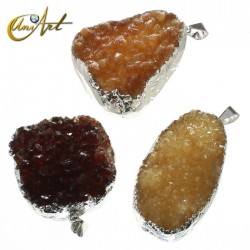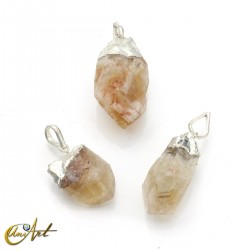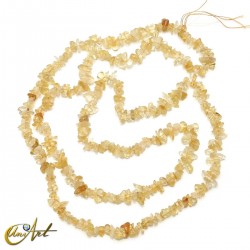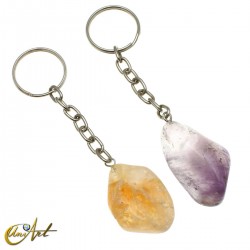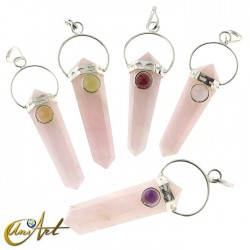Discovering Citrine Quartz and its Properties:

Citrine quartz, an exceptionally captivating gem, stands out in the world of precious stones for its vibrant yellow-gold hue. This stone, whose name evokes images of ripe lemons and golden sunsets, owes its unique coloration to traces of iron present in the quartz's crystalline structure. The term "citrine" comes from the French "citron", alluding to its lemon-like color.
Physical and Chemical Properties of Citrine:
From a scientific perspective, citrine quartz is a form of silicon dioxide. This gem is distinguished from other quartz varieties by its color palette, ranging from pale to deep golden tones. Besides its aesthetic appeal, citrine quartz possesses notable physical properties. With a hardness of 7 on the Mohs scale, it is resilient enough for daily use in jewelry. This hardness, combined with its vitreous luster, makes it a popular choice for a variety of decorative and ornamental applications.
In terms of habit, citrine quartz generally occurs in well-defined crystalline forms, though it can also be found in massive forms. These crystalline characteristics lend it a unique appeal and are one more reason why it is valued both in gem collections and in jewelry making. These features not only define its aesthetic beauty but have also influenced its use throughout history.
Deposits and Availability of Citrine:
Regarding its geological availability, citrine quartz is found in various deposits around the world, with notable reserves in Brazil, Spain, Madagascar, and Russia. The extraction and processing of this precious stone contribute to its availability in the global market, where it is used in a variety of applications, from jewelry to decorative elements.
History and Legends of Citrine:
Citrine quartz has captured the imagination throughout history, although its exact role in ancient cultures often relies on interpretations and legends. It is believed that during the Hellenistic period in ancient Greece, citrine began to be considered a gemstone. This possibility, though not widely documented, suggests an early recognition of its unique beauty.
According to some historical interpretations, the Romans may have sourced their citrine stones from India, a sign of the extensive trade network of the time and the value attributed to this gem.
In many cultures, citrine was considered a stone with a special relationship to the sun, symbolizing light, warmth, and positive energy.
These historical and cultural interpretations reflect the charm and fascination that citrine has inspired over the centuries. They represent how different cultures might have perceived and valued this beautiful gem, adding a layer of mystery and richness to its history.
Citrine in the Esoteric Framework: Symbolism and Uses.
In the esoteric realm, citrine quartz is highly valued for its unique energy and symbolism. Known as the 'Money Gem', it is attributed properties for attracting abundance and prosperity. Many esoteric practices use citrine to promote financial success, as it is believed that this stone acts as a magnet for wealth and helps to maintain it. It is the stone for those who wish to embark on new ventures
Besides its association with abundance, citrine is closely related to the third chakra, also known as Manipura or the solar plexus chakra. This chakra, located in the stomach area, is the center of personal strength and power. Citrine, with its glowing yellow color, is believed to strengthen this chakra, promoting self-confidence, determination, and the ability to make clear decisions.
In astrology, citrine is often associated with the zodiac signs of Gemini, Aries, and Leo. It is said that the stone resonates particularly well with these constellations, providing balance and positive energy. For Gemini, citrine can help balance duality, while for Aries and Leo, it can foster creativity and personal expression.
Due to its energetic properties, citrine is also a popular stone in meditation and healing. It is believed to help dispel negativity and foster joy, making it an ideal stone for those seeking to promote positivity in their lives.
Heated Amethyst vs. Citrine:
Amethyst and citrine are two forms of quartz whose colors are due to iron impurities, but they form under different geological conditions. Amethyst has a natural violet or purple color, originating from the presence of iron and exposure to natural radiation. When artificially heated, amethyst changes color, adopting shades ranging from yellow to orange, thus becoming citrine.
On the other hand, natural citrine acquires its yellow to orange color directly during its geological formation, without the intervention of artificial heating processes. Although both minerals are chemically similar, their colors originate differently.
In the esoteric realm, both heated amethyst and natural citrine are highly valued. It is believed that both stones have the same properties and are energetically equal. Despite the differences in their formation and coloration, in this context, they are attributed similar properties, such as the ability to attract prosperity, success, and positive energies.
Citrine Quartz in Jewelry:
Today, citrine quartz is a highly valued gemstone in the world of jewelry, both for its natural beauty and versatility. This gem, known for its transparency and exceptional luster, lends itself wonderfully to a variety of cuts and styles. Jewelers often opt to facet citrine, a technique that enhances its brilliance and depth of color, creating pieces that capture light and attention. The faceted cut is ideal for showcasing the clarity of the stone and maximizing its light reflection.
In addition to faceted cutting, citrine is also worked into cabochon cuts, a style that gives a smoother and more rounded appearance to the gem. This cut style highlights the purity of the color and is especially popular in more contemporary or minimalist designs. Due to its hardness and resilience, citrine is an ideal choice for all types of jewelry, from rings and pendants to earrings and bracelets. Its color range from light yellow to deep orange makes it extremely attractive for a wide range of tastes and styles.
Besides its appealing aesthetics, citrine is valued in jewelry for its meaning and symbolism. Many people choose citrine for its association with prosperity and joy, believing that the stone can bring positive energy and success to their lives. This combination of natural beauty, durability, and deep meaning makes citrine an excellent choice for high-quality and purposeful jewelry.
Citrine Products
In our online store, you can buy citrine at the best price.

Silver pendant with rough labradorite and faceted gemstone
from €62.92 to €118.58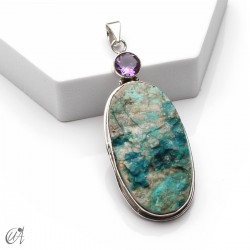
Silver pendant with rough chrysocolla and faceted gemstone
from €47.07 to €105.75Find more products related to citrine

